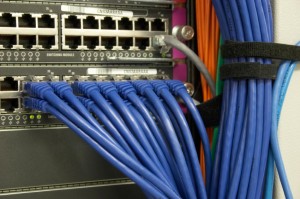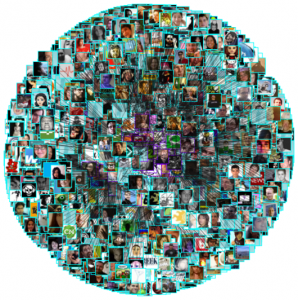This is an interview in Seed Magazine all about Networks.
THE PHYSICIST AND THE POLITICAL SCIENTIST DISCUSS CONTAGION AND THE OBAMA CAMPAIGN, DEBATE THE NATURAL SELECTION OF ROBUSTNESS AND ASK WHETHER SOCIETY IS TURNING INWARD.
ALBERT-LÁSZLÓ BARABÁSI: It is becoming a truism that we’re living in the era of networks. Just about anywhere we turn, we encounter one. We have the World Wide Web and the internet; we have social networks, genetic networks, and biochemical networks. These things — web pages, genes, chemicals in our cells — are nothing new. What is new is that everybody’s waking up to the fact that there is a network behind all of these systems, and we need to think about networks as a common feature of all complex systems. But I don’t know if that’s the way you see it.
 JAMES FOWLER: Well, as a social scientist, I’m always asking, “Why do people do stuff?” So for me, what is most amazing about networks is that they completely transform the way we think about data. For a really long time, we’ve thought about individuals as though they were islands — a Robinson Crusoe model of social science. Being able to integrate information — not just about people, but about theirrelationships — is something that’s completely new.
JAMES FOWLER: Well, as a social scientist, I’m always asking, “Why do people do stuff?” So for me, what is most amazing about networks is that they completely transform the way we think about data. For a really long time, we’ve thought about individuals as though they were islands — a Robinson Crusoe model of social science. Being able to integrate information — not just about people, but about theirrelationships — is something that’s completely new.
The rise of online social networks in the past few years has been very important in this respect. Now we can ask, “What’s happening in that whole complex set of relationships that we could never learn by looking at just each individual?”
ALB: Social networks have also given us a new cache of hard data so we’re no longer talking so abstractly about networks. One of the fundamental surprises, which certainly excites the physics community, is that we keep finding similar organizing principles across widely different systems. That is, if for a moment you forget that one node is a metabolite, the other is a gene, and the third is a person, the networks behind metabolism, genetics, and social systems are very much alike. And this has allowed people — social scientists like you, physicists like me, as well as biologists and economists — to talk together on equal terms.
JF: It’s really breaking down barriers. And I completely agree that it’s data driven, that we have this new information, especially about interactions between people and interactions at the cellular level, that has driven an interest in these methods. But the methods are now driving interest in the data. There’s a lot more interest, for example, in how to define the nodes and the relationships in, say, a set of college students in a dorm. So if we asked them, “Who are your friends?” we can now follow who they call by tracking their cellphone usage, or by tagging their phones with GPS to see who they physically spend time with.
Getting that kind of massive, passive data has now become a goal, because we have these network methods that you and your colleagues have developed.
Facebook in a crowd
JF: I’ve noticed something interesting on Facebook. I’ll have a cluster of friends who are not on Facebook and when one becomes my friend, all of a sudden — in a matter of days — they will all become friends with me, and all become friends with one another until the community is linked.
ALB: That’s right. And then it freezes until some other friends come along and connect another community to you. The phenomenon is not unique to Facebook; the web also evolves through bursts.
JF: Exactly. And in Facebook it’s not so easy for links to go away.
ALB: It’s a wonderful example of how our world has changed thanks to technology. We all have friends whom we’ve accumulated over 20, 30, 40 years, depending on our age. I moved from Transylvania to Hungary and from Hungary to the United States. In the past, most of my previous links were lost. Now they’re all on Facebook and the Hungarian equivalent, called iWiw. Suddenly, these social networking sites become a depository of our personal history. Some elementary school friends recently reconnected with me. People about whom I have to think hard, “Who are they?” Then, I remember, “Oh yes, he was in my fourth grade class.” Now he’s a friend. Because of technology we have stopped hemorrhaging links. And I think this is fundamentally changing how we behave on a daily basis.
JF: I agree. But if we move from five friends in real life to 500 on Facebook, it’s not the case that we are having a close, deep relationship with each of those 500 friends.
ALB: Sure.
JF: In fact, one of the intriguing things I’ve noticed about these online networks is that they have a property that’s different from realworld social networks. As you know, in the real world, popular people tend to be friends with popular people. But in these technological networks, as in metabolic networks, it’s just the opposite. The nodes with many, many links will tend to be linked to nodes with few links.
ALB: Right.
JF: It makes me wonder if the dynamics of online social networks are going to be reflective of realworld social networks. Because to a large extent, in your work and some of the work that I’ve done, we’re relying on the idea that what we see online is telling us something about the real world. But there’s a pretty fundamental difference.
ALB: Which brings up a good point: What do we mean when we say that all the “real-world” networks — the technological, social, and metabolic ones — are similar to each other? They share a few fundamental organizing principles. One that has gotten lots of attention in the scientific community is the existence of the hubs. All of these extremely disparate networks, from the cell that has developed over 4 billion years to the World Wide Web with a 20-year history, have naturally developed these hubs. Somehow, networks always converge to the same underlying scale-free structure.
JF: This really takes us back to Darwin. Which for me, in the social sciences, is a little controversial. But I believe we’re going to find that natural selection is what causes hubs to emerge in all these different networks. You have natural selection operating in the cell. You have it operating on the evolution of the brain. And recently, Nicholas Christakis, Christopher Dawes, and I have found evidence that there’s a genetic basis for human social networks — that the number of people who name you as a friend is actually heritable, and about half of the variation in the number of friends can be explained due to variation in the genes.
ALB: So you mean my genes affect how many people would name me as a friend?
JF: Yes.
ALB: Can I get that gene?
JF: Some of this makes sense, right? Physically attractive people, people who communicate well, people who have assets, are probably going to be more attractive. But we were startled at how strong the genetic effect was. To me, what this really says is that human social networks have been operating under natural selection for a very long time — since we were walking around on the plains of the Serengeti in the Pleistocene. These forces are still with us today. So I really appreciate the effort to explain the variation between the hubs and the isolates in these physics models using a single underlying principle. But what this suggests to me is that it’s not necessarily inherent homogeneity or similarity that brings about some of this variation; it’s actually inherent variation.
There are things that make each of us, as human beings, unique — that give each of us a unique place in the social network. The fact that we’re finding this sort of genetic relationship makes me wonder if there’s actually a genetic purpose. That is, natural selection might have acted on us to make sure that we have a variety of people who are hubs and who aren’t hubs, that we have people within these dense networks, as well as people who act as bridges between groups.
ALB: Wow. I have never heard that one. It’s interesting, because the question of the role of natural selection came up very sharply when we first started to look at cellular networks, when we really didn’t know what to expect. When the data came out, in each case we saw the same scale-free structure, which forced us to say, “Why so?” And now the understanding is that it is because of growth — the fact that each network emerges through the gradual addition of new nodes. The growth process imposes such strong constraints on the network structure that all natural selection does is choose among the many possible scale-free networks. In the case of biological systems, we understand why the cell is scale free. What biologists have shown is that if the main mechanism by which you add new genes to the cell is by gene duplication — that is, you copy and recopy existing genes — then the only network that can emerge from that process is a scale-free network.
JF: So, where does it come from? I mean, if they’re all scale free, then that suggests that natural selection isn’t the cause.
ALB: Right. And actually, one of the important properties of scale-free networks is their robustness. That is, if you start randomly removing nodes from a scale-free network, the network will not collapse. Which initially led us, and many others, to think, “Well, then the reason why the cell is scale free, the reason why the hubs are there, is because of this robustness. It’s good for the cell, therefore natural selection has led the network to be scale free.” Yet nobody has managed to produce a scale-free network that is built on the robustness principle. If you try to optimize a network to be very robust to random node removal, to breakdowns, you’ll never find a scale-free one.
This suggests to us that the scale-free state of the cell, the existence of the hubs, is not because the cell has optimized itself to be resilient against mutations and other types of errors. It’s really coming from the way the cell — just like the internet — is created from the growth process, one node at a time. Since hubs happen to be a desirable property, there is no reason for natural selection to delete them.
